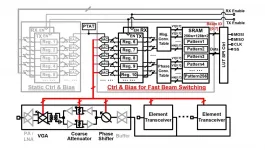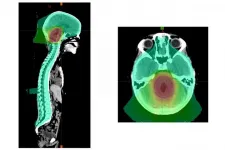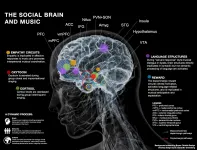(Press-News.org) Scientists at Tokyo Institute of Technology (Tokyo Tech) and NEC Corporation jointly develop a 28-GHz phased-array transceiver that supports efficient and reliable 5G communications. The proposed transceiver outperforms previous designs in various regards by adapting fast beam switching and leakage cancellation mechanism.
With the recent emergence of innovative technologies, such as the Internet of Things, smart cities, autonomous vehicles, and smart mobility, our world is on the brink of a new age. This stimulates the use of millimeter-wave bands, which have far more signal bandwidth, to accommodate these new ideas. 5G can offer data rates over 10 Gbit/s through the use of these millimeter-waves and multiple-in-multiple-out (MIMO) technology--a technology that employs multiple transmitters and receivers to transfer more data at the same time.
Large-scale phased-array transceivers are crucial for the implementation of these MIMO systems. While MIMO systems boost spectral performance, large-scale phased-array systems face several challenges, such as increased power dissipation and implementation costs. One such critical challenge is latency caused by beam switching time. Beam switching is an important feature that enables the selection of the most optimal beam for each terminal. A design that optimizes beam switching time and device cost is, thus, the need of the hour.
Motivated by this, scientists from Tokyo Institute of Technology and NEC Corporation in Japan collaborated to develop a 28-GHz phased-array transceiver that supports fast beam switching and high-speed data communication. Their findings will be discussed at the 2021 Symposia on VLSI Technology and Circuits, an international conference that explores emerging trends and innovative concepts in semiconductor technology and circuits.
The proposed design facilitates dual-polarized operation, in which data is transmitted simultaneously through horizontal and vertical-polarized waves. However, one issue with these systems is cross-polarization leakage, which results in signal degradation, especially in the millimeter-wave band. The research team delved into the issue and developed a solution. Prof. Kenichi Okada, who led the research team, says, "Fortunately, we were able to devise a cross-polarization detection and cancellation methodology, using which we could suppress the leakages in both transmit and receive mode."
One critical feature of the proposed mechanism is the ability to achieve low-latency beam switching and high-accuracy beam control. Static elements control the building blocks of the mechanism, while on-chip SRAM is used to store the settings for different beams (Figure 1). This mechanism leads to fast beam switching with ultra-low latency being achieved. It also enables fast switching in transmit and receive modes due to the use of separate registers for each mode.
Another aspect of the proposed transceiver is its low cost and small size. The transceiver has a bi-directional architecture, which allows for a smaller chip size of 5 × 4.5 mm2 (Figure 2). For a total of 256-pattern beam settings stored within the on-chip SRAM, a beam switching time of only 4 nanoseconds was achieved! Error vector magnitude (EVM)--a measure to quantify the efficiency of digitally modulated signals such as quadrature amplitude modulation (QAM)--was calculated for the proposed transceiver. The transceiver was supported with EVMs of 5.5% in 64QAM and 3.5% in 256QAM.
When compared with state-of-the-art 5G phased-array transceivers, the system has a faster beam switching time and excellent MIMO efficiency. Okada is optimistic about the future of the 28-GHz 5G phased-array transceiver. He concludes, "The technology we developed for the 5G NR network supports high-volume data streaming with low latency. Thanks to its rapid beam switching capabilities, it can be used in scenarios where enhanced multi-user perception is required. This device sets the stage for a myriad of applications, including machine connectivity and the construction of smart cities and factories."
INFORMATION:
This research is supported by the Ministry of Internal Affairs and Communications in Japan (JPJ000254).
Reference
Authors: Jian Pang, Zheng Li, Xueting Luo, Joshua Alvin, Kiyoshi Yanagisawa, Yi Zhang, Zixin Chen, Zhongliang Huang, Xiaofan Gu, Weichu Chen, Yun Wang, Dongwon You, Zheng Sun, Yuncheng Zhang, Hongye Huang, Naoki Oshima, Keiichi Motoi, Shinichi Hori, Kazuaki Kunihiro, Tomoya Kaneko, Atsushi Shirane, and Kenichi Okada
Session: Session 11 Advanced Wireless for 5G, C11-2 (June 17,8:50JST)
Session Title: A Fast-Beam-Switching 28-GHz Phased-Array Transceiver Supporting Cross-Polarization Leakage Self-Cancellation
Conference: 2021 Symposia on VLSI Technology and Circuits
Affiliations: Tokyo Institute of Technology, NEC Corporation
About Tokyo Institute of Technology
Tokyo Tech stands at the forefront of research and higher education as the leading university for science and technology in Japan. Tokyo Tech researchers excel in fields ranging from materials science to biology, computer science, and physics. Founded in 1881, Tokyo Tech hosts over 10,000 undergraduate and graduate students per year, who develop into scientific leaders and some of the most sought-after engineers in industry. Embodying the Japanese philosophy of "monotsukuri," meaning "technical ingenuity and innovation," the Tokyo Tech community strives to contribute to society through high-impact research.
https://www.titech.ac.jp/english/
Medulloblastoma is a rare but devastating childhood brain cancer. This cancer can spread through the spinal fluid and be deposited elsewhere in the brain or spine. Radiation therapy to the whole brain and spine followed by an extra radiation dose to the back of the brain prevents this spread and has been the standard of care. However, the radiation used to treat such tumors takes a toll on the brain, damaging cognitive function, especially in younger patients whose brains are just beginning to develop.
A national study led by Washington University School of Medicine in St. Louis and St. Jude Children's Research Hospital suggests that children with what is called "average risk medulloblastoma" can receive a radiation "boost" to a smaller ...
Metformin is a widely prescribed blood sugar-lowering drug. It is often used as an early therapy (in combination with diet and lifestyle changes) for type 2 diabetes, which afflicts more than 34 million Americans.
Metformin works by lowering glucose production in the liver, reducing blood sugar levels that, in turn, improve the body's response to insulin. But scientists have also noted that metformin possesses anti-inflammatory properties, though the basis for this activity was not known.
In a study published online June 8, 2021 in the journal END ...
Married men who don't help out around the house tend to bring home bigger paychecks than husbands who play a bigger role on the domestic chores front.
New research from the University of Notre Dame shows that "disagreeable" men in opposite-sex marriages are less helpful with domestic work, allowing them to devote greater resources to their jobs, which results in higher pay.
In contemporary psychology, "agreeableness" is one of the "Big Five" dimensions used to describe human personality. It generally refers to someone who is warm, sympathetic, kind and cooperative. Disagreeable people do not tend to exhibit these characteristics, and they tend to ...
An estimated 8 million tons of plastic trash enters the ocean each year, and most of it is battered by sun and waves into microplastics--tiny flecks that can ride currents hundreds or thousands of miles from their point of entry.
The debris can harm sea life and marine ecosystems, and it's extremely difficult to track and clean up.
Now, University of Michigan researchers have developed a new way to spot ocean microplastics across the globe and track them over time, providing a day-by-day timeline of where they enter the water, how they move and where they tend to collect.
The approach relies on ...
Have you ever been cut off in traffic by another driver, leaving you still seething miles later? Or been interrupted by a colleague in a meeting, and found yourself replaying the event in your head even after you've left work for the day? Minor rude events like this happen frequently, and you may be surprised by the magnitude of the effects they have on our decision-making and functioning. In fact, recent research co-authored by management professor Trevor Foulk at the University of Maryland's Robert H. Smith School of Business suggests that in certain situations, incidental rudeness like this can be deadly.
In "Trapped ...
HOUSTON - (June 10, 2021) - Leaders who encourage their employees to learn on the job and speak up with ideas and suggestions for change have teams that are more effective and resilient in the face of unexpected situations, according to new research from Rice University and the University of Windsor.
"A Resource Model of Team Resilience Capacity and Learning" will appear in a special issue of Group & Organization Management. Authors Kyle Brykman, an assistant professor at the Odette School of Business at the University of Windsor, and Danielle King, an ...
Music is a tool that has accompanied our evolutionary journey and provided a sense of comfort and social connection for millennia. New research published today in the American Psychologist provides a neuroscientific understanding of the social connection with a new map of the brain when playing music.
A team of social neuroscientists from Bar-Ilan University and the University of Chicago introduced a model of the brain that sheds light on the social functions and brain mechanisms that underlie the musical adaptations used for human connection. The model is unique because it focuses on what happens in the brain when people make music together, rather than when they listen to music individually.
The research was inspired by creative efforts of people around the world to reproduce ...
Chestnut Hill, Mass. (6/10/2021) - A British man who rejected the standard of care to treat his brain cancer has lived with the typically fatal glioblastoma tumor growing very slowly after adopting a ketogenic diet, providing a case study that researchers say reflects the benefits of using the body's own metabolism to fight this particularly aggressive cancer instead of chemo and radiation therapy.
Published recently in the journal Frontiers in Nutrition, the report is the first evaluation of the use of ketogenic metabolic therapy (KMT) without chemo or radiation interventions, on a patient diagnosed with IDH1-mutant glioblastoma (GBM). Ketogenic therapy is a non-toxic nutritional approach, viewed as complementary or ...
Just as the governor announced the start of python hunting season in Florida this month, researchers at the University of Central Florida have published a first- of-its-kind study that shows that near-infrared (NIR) spectrum cameras can help hunters more effectively track down these invasive snakes, especially at night.
The snakes, which can reach 26 feet in length and 200 pounds, have invaded the Everglades in Florida -- threatening native species and disrupting the ecosystem. The number of common native species observed in the Everglades since the snakes were first discovered in the 1990s dropped in some species by 90% through 2010, according ...
ITHACA, N.Y. - Researchers from Cornell University's School of Applied and Engineering Physics and Samsung's Advanced Institute of Technology have created a first-of-its-kind metalens - a metamaterial lens - that can be focused using voltage instead of mechanically moving its components.
The proof of concept opens the door to a range of compact varifocal lenses for possible use in many imaging applications such as satellites, telescopes and microscopes, which traditionally focus light using curved lenses that adjust using mechanical parts. In some applications, moving traditional glass or plastic lenses ...




